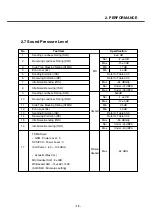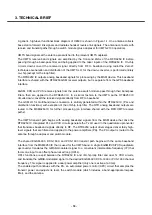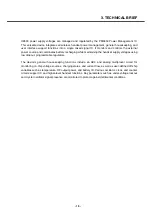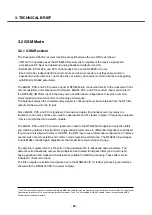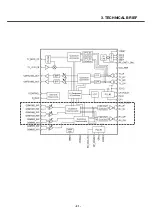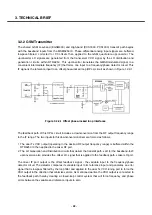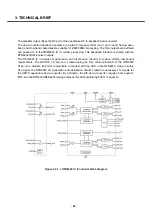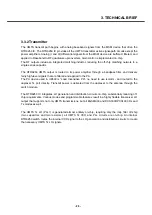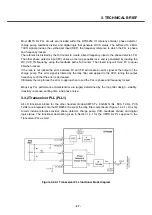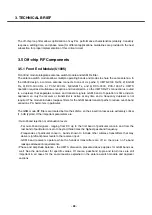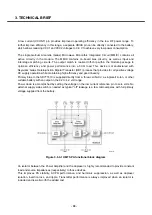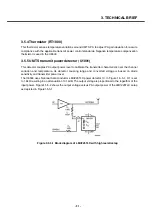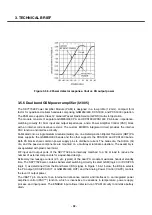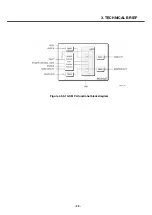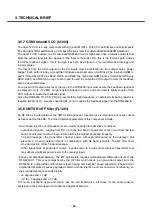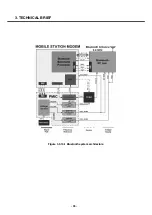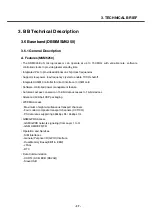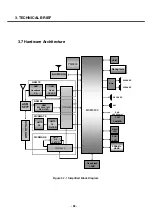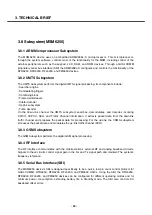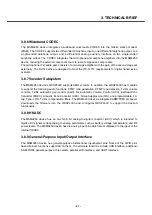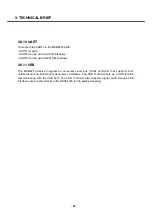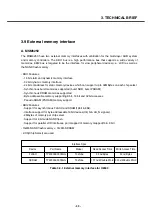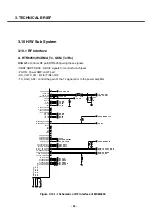
3. TECHNICAL BRIEF
- 29 -
3.5.2 UMTS duplexer (FL1000)
A UMTS duplexer splits a single operating band into receive and transmit paths. Important
performance requirements include:
-. Insertion loss . this component is also in the receive and transmit paths; In the U8500 typical losses:
UMTS Tx = 1.2 dB, UMTS Rx = 1.5 dB.
-. Out-of-band rejection or attenuation . the duplexer provides input selectivity for the receiver, output
filtering for the transmitter, and isolation between the two. Rejection levels for both paths are
specified over a number of frequency ranges. Two Tx-to-Rx isolation levels are critical to receiver
performance:
-. Rx-band isolation . the transmitter is specified for out-of-band noise falling into the Rx band. This
noise leaks from the transmit path into the receive path, and must be limited to avoid degrading
receiver sensitivity. The required Rx-band isolation depends on the PA out of-band noise levels and
Rx-band losses between the PA and LNA. Typical duplexer Rx band isolation value is 45 dB.
-. Tx-band isolation . the transmit channel power also leaks into the receiver. In this case, the leakage
is outside the receiver passband but at a relatively high level. It combines with Rx band jammers to
create cross-modulation products that fall inband to desensitize the receiver. The required Tx-band
isolation depends on the PA channel power and Tx-band losses between the PA and LNA. Typical
duplexer Tx-band isolation value is 50 dB.
-. Passband ripple . the loss of this fairly narrowband device is not flat across its passband. Passband
ripple increases the receive or transmit insertion loss at specific frequencies, creating performance
variations across the band.s channels, and should be controlled.
-. Return loss . minimize mismatch losses with typical return losses of 10 dB or more (VSWR <2:1).
-. Power handling . high power levels in the transmit path must be accommodated without degraded
performance. The specified level depends on the operating band class and mobile station class (per
the applicable standard), as well as circuit losses and antenna EIRP. Several duplexer
characteristics depend upon its source and load impedances. QUALCOMM strongly recommends an
isolator be used between the UMTS PA and duplexer to assure proper performance.
3.5.3 UMTS Power Amplifier (U1002)
The SKY77410 Load Insensitive Power Amplifier (LIPA¢‚) module is a fully matched 16-pin surface
mount module developed for Wideband Code Division Multiple Access (WCDMA) applications. This
small and efficient power amplifier packs full coverage of the 1850-1980 MHz bandwidth into a single
compact package.
SKY77410 meets the stringent spectral linearity requirements of WCDMA transmission with high
power added efficiency for power output of up to 28 dBm, even with a load mismatch of 4:1 VSWR -
eliminating the need for an isolator.
Summary of Contents for U8500
Page 1: ...Date February 2006 Issue 1 0 Service Manual Model U8500 Service Manual U8500 ...
Page 20: ...3 TECHNICAL BRIEF 21 ...
Page 32: ...3 TECHNICAL BRIEF 33 Figure 3 5 6 1 GSM PA functional block diagram ...
Page 35: ...3 TECHNICAL BRIEF 36 Figure 3 5 10 1 Bluetooth system architecture ...
Page 50: ...3 TECHNICAL BRIEF 51 Figure 3 10 3 2 1 PM6650 Functional Block Diagram ...
Page 114: ...4 TROUBLE SHOOTING 115 Loud Speaker U502 U503 Amp ...
Page 118: ...4 TROUBLE SHOOTING 119 C200 C201 for MIC serial capacitor ...
Page 121: ...4 TROUBLE SHOOTING 122 Q404 Q403 Q402 VBATT GND ...
Page 143: ...6 BLOCK DIAGRAM 144 6 3 Interface Diagram U8500 Interface Diagram ...
Page 145: ... 146 ...
Page 154: ... 155 U8500 8 PCB LAYOUT ...
Page 155: ... 156 8 PCB LAYOUT U8500 ...
Page 156: ... 157 8 PCB LAYOUT ...
Page 157: ... 158 8 PCB LAYOUT ...
Page 158: ... 159 U8500 8 PCB LAYOUT ...
Page 159: ... 160 U8500 8 PCB LAYOUT ...
Page 166: ...9 CALIBRATION 167 Click START button U8500 U8500_ver1 1 U8500 U8500 Click U8500 ...
Page 167: ... 168 ...
Page 169: ... 170 ...
Page 194: ...Note ...
Page 195: ...Note ...

